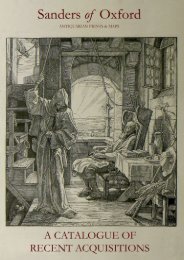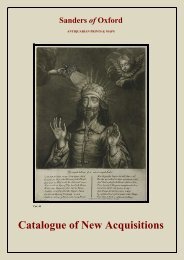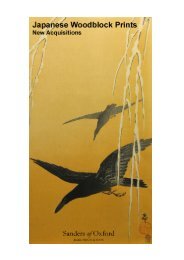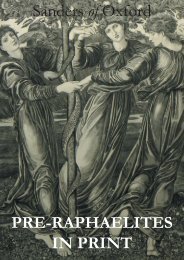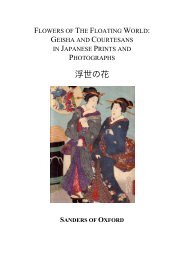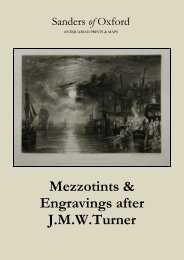Surimono catalogue FINAL WEB.pdf - Sanders of Oxford
Surimono catalogue FINAL WEB.pdf - Sanders of Oxford
Surimono catalogue FINAL WEB.pdf - Sanders of Oxford
Create successful ePaper yourself
Turn your PDF publications into a flip-book with our unique Google optimized e-Paper software.
ukiyo-e printmaking. The many surimono <strong>of</strong> birds, animals and flowers<br />
may have encouraged Hiroshige to design commercial prints <strong>of</strong> these<br />
subjects and Hokusai and Hokkei’s designs <strong>of</strong> historical and legendary<br />
figures were a direct inspiration for Kuniyoshi’s popular Suikoden series.<br />
The demand for surimono waned by the 1830s as subject matter that<br />
had not previously been addressed in commercial printing began to<br />
appear in ukiyo-e woodblocks, reducing the need for the works that had<br />
first inspired them. Towards the end <strong>of</strong> the 19 th and into the 20 th century<br />
reproductions <strong>of</strong> early surimono made between 1810 and 1830 were<br />
produced. Principally sold to Western tourists in Japan, these copies have<br />
become known as Akashi surimono after the town in which they were<br />
made. Akashi surimono are extremely fine reproductions incorporating the<br />
same lavish features <strong>of</strong> the originals, such as blind printing and the ornate<br />
use <strong>of</strong> rich pigments. The most tangible difference was merely the rigidity<br />
and colour <strong>of</strong> the paper, the 1820s hōsho being s<strong>of</strong>ter and more porous<br />
than the later paper, which also had the tendency to turn a slight brown<br />
colour due to the sizing used. Akashi suirmono were <strong>of</strong>ten mistaken for<br />
the originals until the 1970s and it was Roger Keyes groundbreaking<br />
research and subsequent essay in his 1985 book The Art <strong>of</strong> <strong>Surimono</strong><br />
that has defined Akashi and their groupings. Keyes found that Akashi<br />
surimono in the square format fall into four categories A, B, C, and D. The<br />
groups are defined by the quality <strong>of</strong> reproduction with A being the highest<br />
quality. Keyes also created a list <strong>of</strong> known Akashi surimono which has<br />
aided in identifying them from the originals.<br />
In this <strong>catalogue</strong> we present a collection <strong>of</strong> original and Akashi surimono.<br />
All but one <strong>of</strong> the Akashi surimono are Meiji A copies. Original surimono<br />
prints are scarce because they were privately published in such limited<br />
numbers. Akashi surimono have become collectible in the own right,<br />
many are rare themselves and <strong>of</strong>ten depict surimono for which there is no<br />
known original. Whilst Akashi surimono were reproduced with the same<br />
techniques as the originals that they copy, they are much less expensive<br />
than the originals, another factor which has fuelled their collectability.




